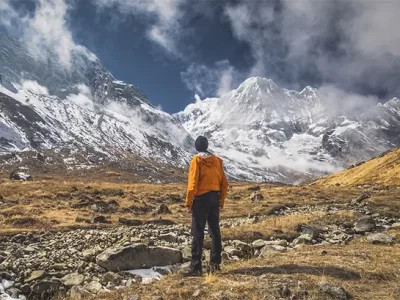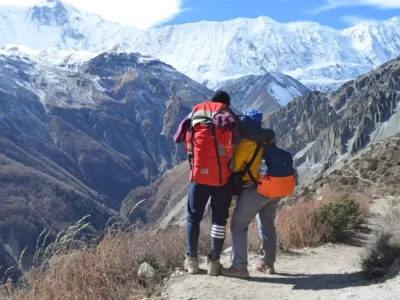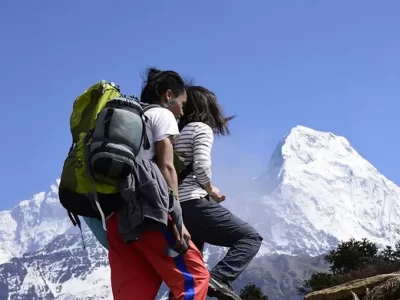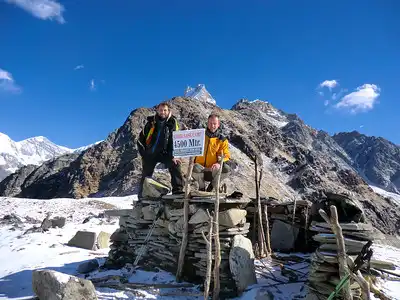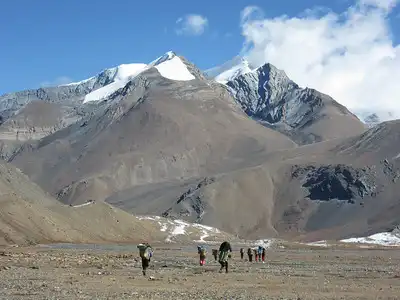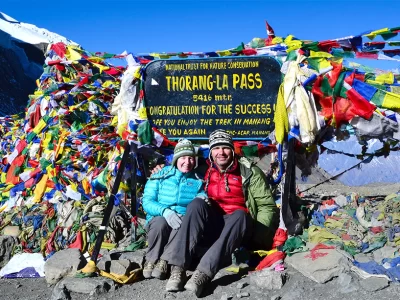Trekking in the Annapurna Region offers stunning views of the majestic Himalayas. Annapurna Region Trekking takes place in the central part of Nepal. Here, you will see Annapurna I, the world’s tenth-tallest peak, and many other towering mountains. Trekkers can choose from easy climbs in the foothills to challenging high-altitude adventures. An Annapurna region map will show you a variety of landscapes.
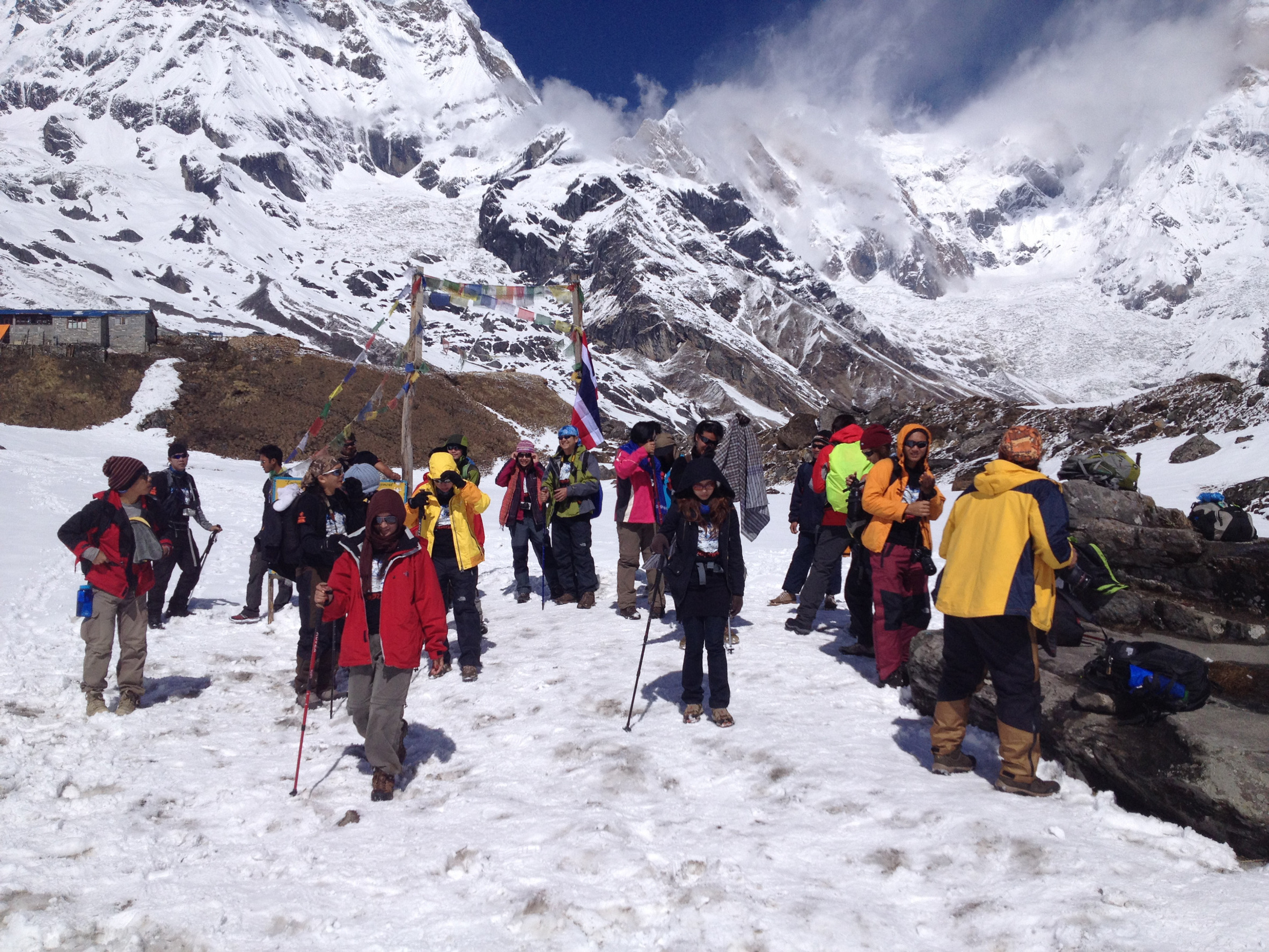
You can explore lush valleys, terraced fields, dramatic gorges, and glaciers. This region’s treks are special because they combine adventure with cultural experiences. Many treks go through charming villages where people still follow ancient traditions. Hikers might see prayer flags blowing in the wind.
They might also see colorful festivals or spend a night in a cozy teahouse trying local food. The biodiversity is another highlight. Hikers in lower areas might spot colorful birds and blooming wildflowers. Hikers on higher paths might see rare animals like musk deer and Himalayan tahr.
Top 5 Treks in Annapurna Region are listed below:
Annapurna Base Camp Trek
Annapurna Circuit Trek
Ghorepani Poon Hill Trek
1. Annapurna Base Camp Trek
The Annapurna Base Camp Trek attracts trekkers from all over the world. Annapurna Base Camp sits at an elevation of 4,130 meters. It provides access to the majestic Mount Annapurna. This peak, standing at 8,091 meters, ranks as the 10th highest in the world. The ABC Trek offers an unforgettable experience, captivating those who undertake this iconic Himalayan trek.
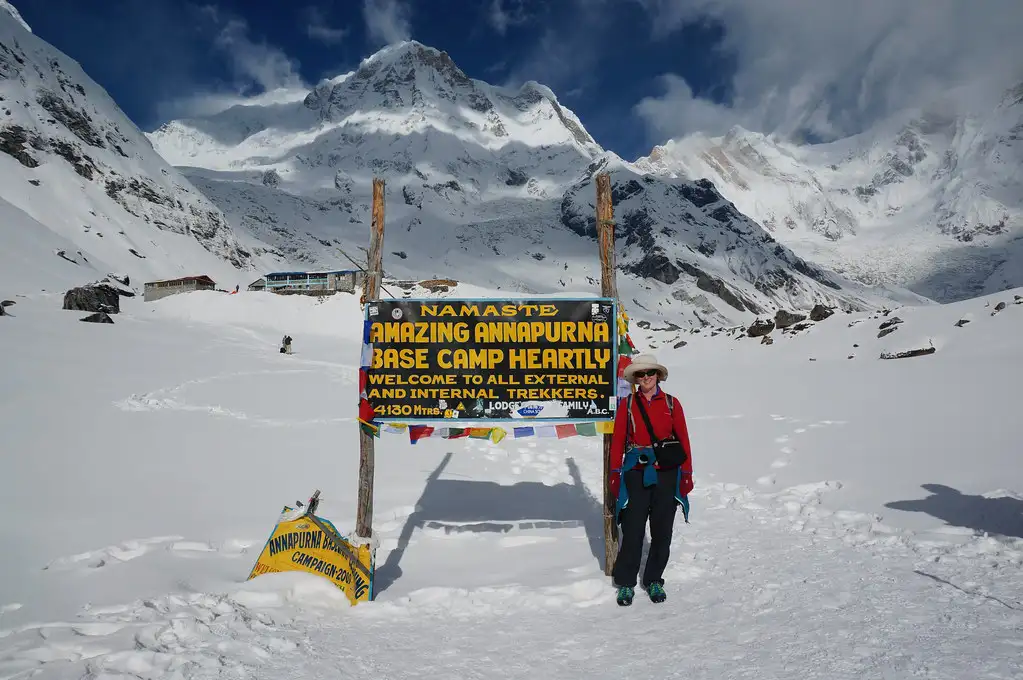
The Annapurna Sanctuary offers a unique and breathtaking setting, surrounded by famous peaks such as Annapurna I (8,091 m), Annapurna South (7,219 m), Machapuchhre (6,993 m), and Hiunchuli (6,441 m). Renowned for its significant altitude variation and diverse ecosystems, ABC trekking allows for extraordinary exploration. Paths wind through lush forests filled with rhododendrons, picturesque rice paddies, and terraced farmlands. These trails offer unparalleled views of the Annapurna base camp and surrounding mountains.
Experience the splendor of towering mountains and the rich cultural fabric of Nepalese life on the Annapurna Base Camp Trek. It offers more than just sightseeing. Trekkers engage deeply with the local cultures and traditions of the ethnic Gurungs, Magars, Thakalis, and Lobas along the way.
Highlights
- Sunrise Views: Catch the early morning sun casting golden hues over the Annapurna and Dhaulagiri ranges from Poon Hill.
- Annapurna Sanctuary: Explore the breathtaking Annapurna Sanctuary, encircled by towering peaks like Annapurna I.
- Local Wildlife: Discover a variety of wildlife, such as the Himalayan Tahr and langur monkeys, amid the trek’s natural landscapes.
- Machhapuchhre Base Camp: Approach the untouched base of Machhapuchhre Mountain, revered for its distinctive fishtail shape.
- Cultural Interaction: Connect with the lifestyles, traditions, and cuisines of the local Gurung and Magar communities along the trail.
Best Time to Trek
Spring (March to May): Spring has good weather with not too hot, not too cold temperatures between 10°C and 20°C. Sometimes, snow comes down from the sky quickly, or big storms happen, especially up high in the mountains. It can make trekking dangerous. But helicopters are ready to rescue people if needed, since paths are clear and weather is nice. Many trekkers go in spring because of the good weather. This means trails are crowded, but there are more groups to trek with.
Autumn (September to November): The weather in autumn is good, and the skies are clear, great for trekking. Emergencies don’t happen as much, but temperatures can drop fast, and it might snow up high. Helicopter rescues work well in autumn to keep trekkers safe. Many trekkers come in autumn because of the ideal weather and fun festivals happening.
Winter (December to February): Winter is the season of cold and snow. Winter brings challenges and scenic beauty. There is a high risk of avalanches and severe weather. People need to be very careful. There are fewer helicopter services in winter due to bad weather. Rescues become very hard. Winter has fewer trekkers on the trails. It is quiet, but fewer facilities are open.
Monsoon (June to August): Monsoon brings frequent rain. The trails get wet and slippery. There is a high risk of landslides and floods. Trekkers need to be cautious. Helicopter rescues become less frequent and more risky due to low visibility and landslides. The number of trekkers drops a lot. The trails are quieter, but fewer services are available.
Route Description
The trek to Annapurna Base Camp starts from Pokhara, often at Nayapul or Phedi, and leads through diverse landscapes and vibrant villages. Key points of interest include:
Poon Hill: Trekkers begin their adventure with a visit to Poon Hill, a prominent viewpoint famous for its breathtaking sunrise views.
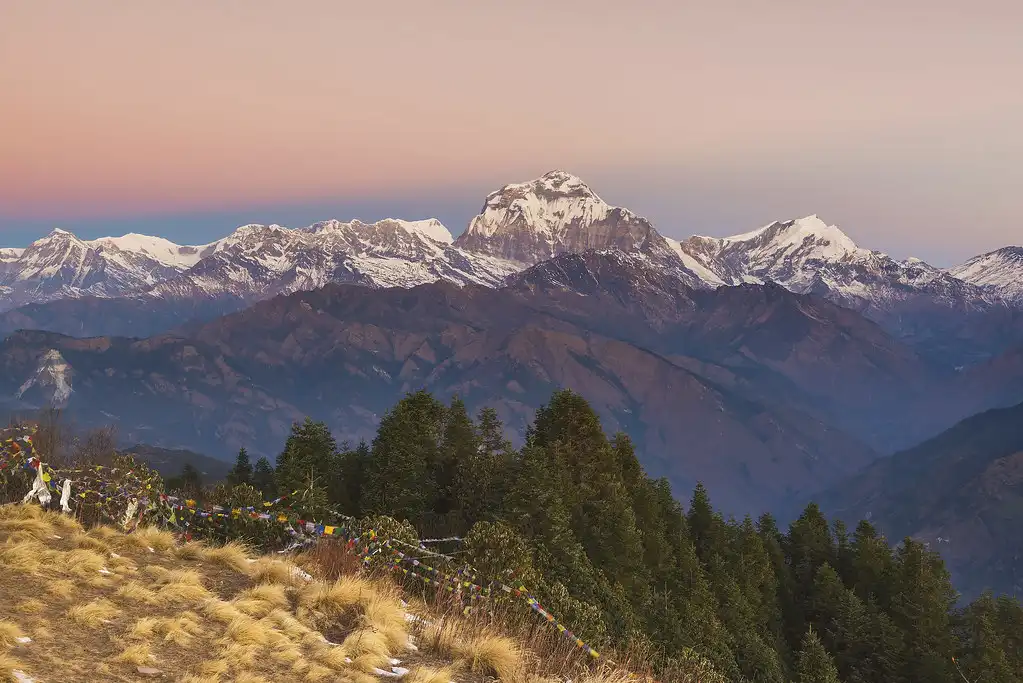
Here, you can gaze across the expansive horizon to see the Annapurna and Dhaulagiri ranges illuminated by the early morning light. The accessible viewpoint offers some of the most photogenic opportunities in the region.
Chhomrong: As the trek progresses, you will arrive at Chhomrong, a picturesque Gurung village that acts as a crucial junction on the path to Annapurna Base Camp. Nestled at a strategic point, Chhomrong opens into the deeper valleys of the Annapurna Sanctuary.
Machhapuchhre Base Camp (MBC): Before reaching Annapurna Base Camp, you will stop at Machhapuchhre Base Camp, which allows a close encounter with the majestic Machhapuchhre mountain, famously known as the Fishtail for its distinctive peak shape.
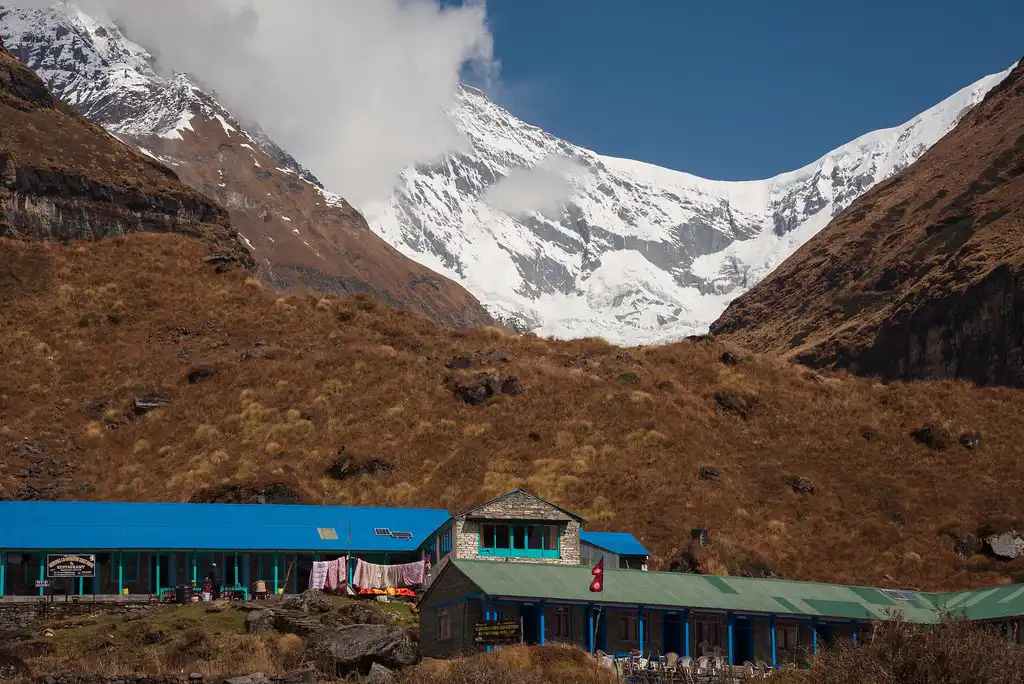
This base camp serves as both a rest point and a vantage spot to admire the rugged mountain up close, surrounded by high ridges in a serene setting.
Annapurna Base Camp (ABC): The trek reaches its climax at Annapurna Base Camp, situated at an elevation of 4,130 meters. This location is surrounded by a spectacular ring of peaks, forming a natural mountain fortress. Offering incredible natural beauty, ABC is the ultimate reward for trekkers, providing unmatched panoramic views of the surrounding mountains and making you feel surrounded by the giants of the Himalayas.
Annapurna Region Trekking Challenges
Altitude Sickness: As trekkers ascend over 4,000 meters on the Annapurna Base Camp Trek, they face increasing risks of Acute Mountain Sickness (AMS). Symptoms like headaches, nausea, and dizziness may appear and could escalate to more severe health issues if not managed properly. Trekkers must acclimatize effectively, climbing slowly to allow their bodies to adjust to higher altitudes and ensure they stay hydrated. Recognizing and addressing the symptoms of AMS early, through rest or descent, is crucial.
Physical Demands: Steep ascents and descents characterize the Annapurna Base Camp Trek, demanding good physical fitness and stamina. Trekkers usually walk 5 to 7 hours daily, facing considerable elevation gain. Preparation should include regular cardiovascular and strength training well before the trek. Using trekking poles and carrying a light backpack will also help manage the physical challenges.
Accommodation and Permits
Lodging: Teahouses and guesthouses along the Annapurna Base Camp route provide accommodations ranging from basic to comfortable. These establishments offer essential services such as beds, hot meals, and bathroom facilities. Luxury is minimal in more remote areas. You’ll need to book accommodations beforehand, especially during the busy spring and autumn seasons, or arrange them through a trekking agency if you don’t mind.
Permits
Trekkers must obtain specific permits for trekking in the Annapurna region:
Annapurna Conservation Area Permit (ACAP): This permit is essential for all trekkers and supports conservation efforts in the Annapurna region.
Trekkers’ Information Management System (TIMS) Card: This card helps ensure the safety and security of trekkers and maintains records for use in emergencies or accidents.
Mardi Himal Trek
Dhaulagiri Trek
Mini Annapurna Circuit Trek
2. Annapurna Circuit Trek
The Annapurna Circuit Trek is famous worldwide as a top trekking spot. It loops around the Annapurna massif, showing off varied landscapes from lush jungles to stark, high-altitude deserts. Its mix of cultures and amazing views make it popular with trekkers everywhere.
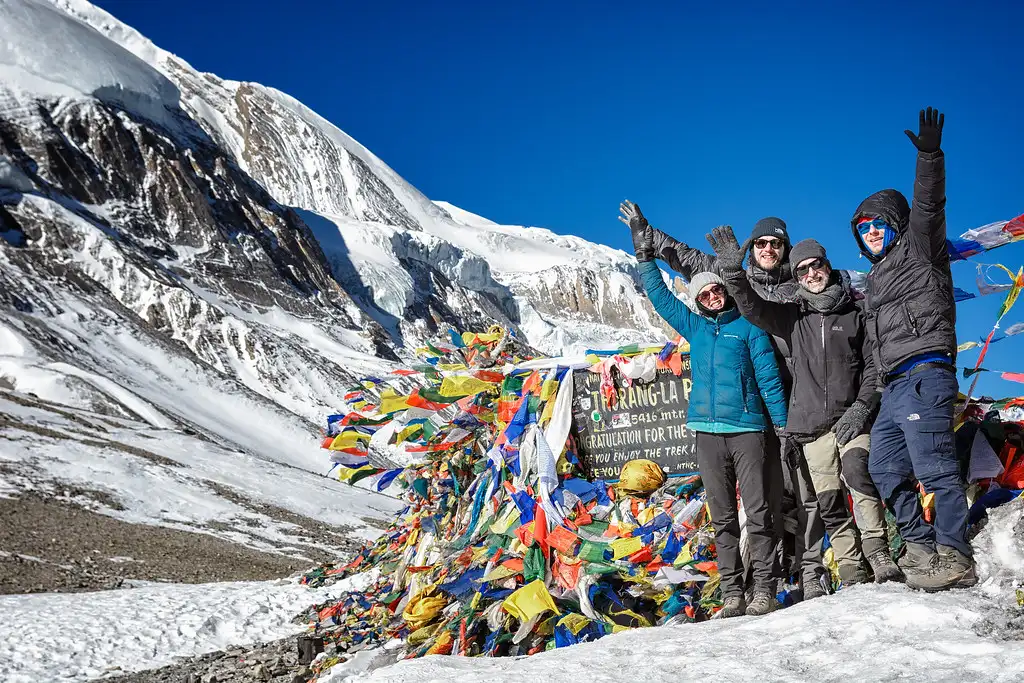
Adventure lovers see trekking the Annapurna Circuit as a key adventure. The paths are tough and cover different climate zones. They start in warm, tropical areas and climb to cold, arctic heights, offering exciting and varied experiences.
The Thorong La Pass highlights the trek’s importance in Nepal’s trekking community. At 5,416 meters high, crossing this pass gives trekkers wide views and a great feeling of success. This part really makes the Annapurna Circuit a must-visit for those who love adventures.
Highlights
- Thorong La Pass: Reach the trek’s zenith at 5,416 meters, where you can enjoy expansive views across the Annapurna range.
- Cultural Encounters: Immerse yourself in the rich cultures of the Gurung, Manangi, and Thakali communities, gaining valuable insights into their traditions and daily lives.
- Diverse Landscapes: Navigate through varied terrains, from lush subtropical woodlands and patterned terraced fields to the stark beauty of high-altitude deserts.
- Muktinath Temple: Explore this venerated site, cherished by Hindus and Buddhists alike, which showcases the religious harmony of Nepal.
- Hot Springs at Tatopani: Unwind in the therapeutic natural hot springs, a perfect remedy to rejuvenate after rigorous trekking days.
Best Time to Trek
Spring (March to May) Spring marks one of the best times to trek the Annapurna Circuit, offering stable and warm weather with excellent visibility. Vibrant blooms enhance the trails’ beauty during this season. Trekkers face fewer weather-related emergencies in spring, though occasional showers and sudden temperature drops can occur. Clear skies generally improve the accessibility of helicopter rescue services. As the number of trekkers rises significantly, the trails become lively but crowded at popular spots.
Autumn (September to November) Autumn competes with spring for the best trekking conditions on the Annapurna Circuit. Stable weather, mild temperatures, and clear skies provide exceptional mountain views. Emergencies are rare, but trekkers should watch for early snowfalls at higher elevations. Helicopter rescues operate efficiently thanks to favorable weather. Many trekkers visit in autumn, making it a busy trekking period.
Winter (December to February) Winter offers a challenging yet serene trekking experience with fewer trekkers. Extremely cold temperatures prevail, especially at higher elevations, and snowfall is common. It increases emergency risks, such as avalanches or severe cold-related injuries. Poor weather conditions and shorter daylight hours make helicopter services less reliable. Trekkers must prepare well for harsh conditions if they trek in winter.
Monsoon (June to August): The monsoon season is the least favorable time to trek the Annapurna Circuit, as heavy rains make trails slippery and increase landslide risks. Reduced visibility and cloud-covered mountains are common. Emergencies occur more frequently, and continuous rain and fog can hinder helicopter rescues. Fewer trekkers choose this season, resulting in quieter trails but higher risks.
Route Description
Starting at Besisahar or Bhulbhule, the trek ascends along the Marsyangdi River, passing through vibrant subtropical forests and terraced rice paddies. The path climbs into arid, high-altitude regions, showcasing a variety of geographic contrasts. Key landmarks along the circuit include:
Manang: Serves as a pivotal cultural and acclimatization spot, providing insights into local lifestyles and a necessary rest before the higher climbs.
Thorong La Pass: This pass rises to 5,416 meters, challenging trekkers and offering stunning panoramic views of the nearby peaks.
Muktinath: It stands as a significant pilgrimage site that illustrates the spiritual coexistence of Hindu and Buddhist traditions.
Marpha: Known for its delicious apples and iconic stone-built Thakali houses.
Tatopani: Provides an opportunity to relax in the rejuvenating hot springs surrounded by scenic beauty.
Challenges
Weather Conditions: A wide variety of weather conditions across the diverse elevations of the Annapurna Circuit can change suddenly, especially in the high mountain passes where trekkers may face unexpected storms or snowfalls. Trekkers need to prepare by equipping themselves with suitable gear and keeping updated with weather forecasts throughout their trek.
High Altitude Considerations: The substantial elevation gain throughout the trek makes acclimatization days essential to adapt to the lower oxygen levels at higher altitudes and minimize the risk of altitude sickness. Trekkers must be vigilant about recognizing the early symptoms of altitude sickness and take appropriate actions to ensure their safety.
Accommodation and Permits
Lodging: Along the Annapurna Circuit, teahouses and lodges provide essential services ranging from basic to moderate amenities, offering trekkers warm beds and hearty meals necessary after long trekking days. Trekkers should book lodging in advance, especially during the busy seasons of spring and autumn, to secure accommodation.
Permits: Trekkers must secure several permits to access the Annapurna Circuit: the Annapurna Conservation Area Permit (ACAP) and the Trekkers’ Information Management System (TIMS) card. They must obtain these permits in Kathmandu or Pokhara before beginning the trek. These permits are crucial for environmental conservation and ensuring trekker safety. They regulate access and contribute to maintaining and sustaining the trekking routes and local infrastructure.
3. Mardi Himal Trek
Exploring the untouched beauty of nature close to the Himalayas is a rare opportunity. Walking through the secluded villages of Nepal and traversing the vibrant forests filled with rhododendrons, pines, and oaks captures the essence of this mountainous nation. Recognized globally as one of the premier trekking destinations, Nepal rightly tops the list.
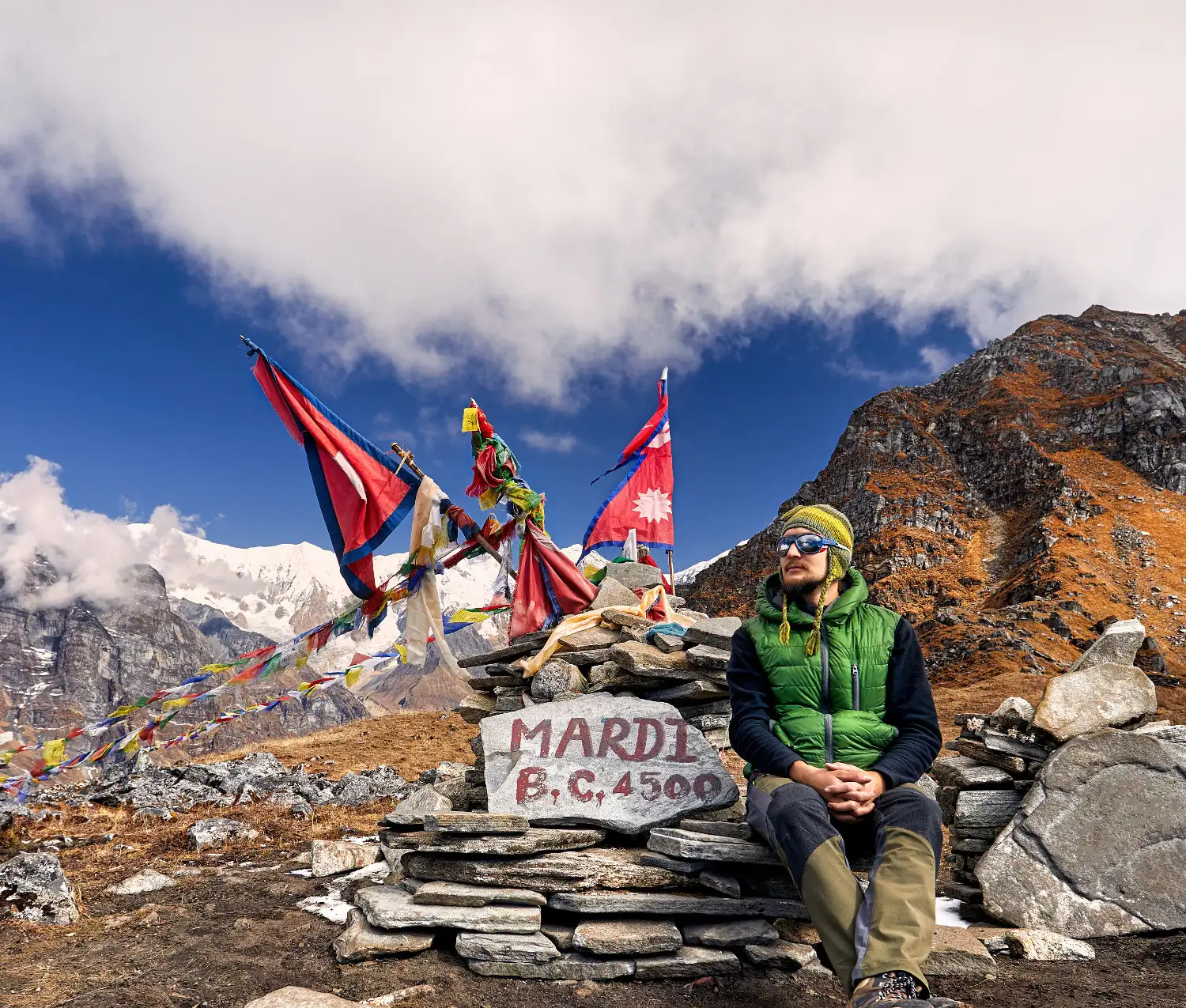
The Annapurna region, known for centuries, offers the Mardi Himal Trek, leading adventurers through one of the quieter areas of Annapurna along a trail still relatively undiscovered by the world. The trail has been open to trekkers since 2012, positioning Mardi Himal as a hidden treasure. Numerous trekkers have ventured to the base of Mardi Himal, nestled alongside Annapurna. The genuine teahouses, tranquil paths, straightforward routes, and stunning views of the Annapurna Range contribute to this extraordinary trek.
Coming face-to-face with towering peaks like Machhapuchhre, Annapurna South, Mardi Himal, and Hiunchuli is truly captivating. The trail is especially vibrant in spring, adorned with various colors of rhododendrons—pink, red, and white. The trek spans ecosystems from tropical farmlands to high alpine vegetation, showcasing a remarkable diversity of flora.
As you walk through the Annapurna Conservation Area, you may also encounter various Nepalese wild animals. The Mardi Himal Trek offers more than just mountain vistas; it’s a harmonious mix of Nepalese tradition, wilderness, comfort, and adventure.
Highlights
- Mardi Himal Base Camp: Capture the stunning up-close views of Mardi Himal, offering breathtaking panoramas of the surrounding peaks.
- Rhododendron Forests: Walk through vibrant forests brimming with colorful rhododendrons, which are particularly spectacular during the spring bloom.
- Remote Trails: Revel in the tranquility of less-traveled paths that provide a peaceful trekking experience away from the usual crowds.
- Views of Iconic Peaks: Gain close-up experiences with renowned mountains such as Machhapuchhre (Fishtail), Annapurna South, and Hiunchuli.
- Cultural Experience: Immerse yourself in local traditions and ways of life by interacting with residents and staying in authentic teahouses and quaint villages along the route.
Best Time to Trek
Spring (March to May) Spring ranks as one of the best times to trek Mardi Himal, offering stable weather and moderate temperatures. Rhododendron blossoms line the trails, enhancing the visual appeal of the trek. Weather-related emergencies rarely occur during these months, although you might still encounter occasional rain showers and fog. Helicopter rescue operations generally run smoothly due to clearer skies. Many trekkers choose this period for its optimal weather conditions and clear mountain views, making the trails busier.
Autumn (September to November) Autumn stands out as another ideal season for trekking Mardi Himal. The weather stays cool and stable, providing clear skies and excellent visibility of the Himalayas. Emergencies are infrequent during this season. Helicopter services are readily available, ensuring safety in case of incidents. The popularity of this season means the trails often get busy, offering trekkers favorable conditions and panoramic views.
Winter (December to February) Winter brings harsh conditions to the Mardi Himal trek, with cold temperatures and potential snow at higher altitudes. Emergencies become more likely due to icy paths and severe weather. Helicopter rescues may face reliability issues due to adverse weather conditions and limited visibility. The trails are less crowded, however, offering a solitary experience for those prepared for the cold.
Monsoon (June to August) Trekking Mardi Himal during the monsoon season generally comes with challenges. Heavy rainfall can make trails slippery and obscure visibility. Landslides and flooding become much more likely, increasing emergency risks. Helicopter rescue efforts become more complex and less frequent in poor weather. Only some trekkers opt for this season, resulting in quieter trails but increased dangers.
Route Description
The Mardi Himal Trek begins at Kande or Phedi, just a short drive from the lakeside city of Pokhara. Initially, the path climbs through dense rhododendron forests up to the scenic Australian Camp, celebrated for its breathtaking sunrises and sunsets against the backdrop of the Annapurna range. The route then leads trekkers through Pothana and up to the ridge-top settlement of Deurali, providing sweeping views of the valley below.
Forest Camp: Also known as Kokar, this secluded spot lies deep within thick forests. It provides a tranquil setting ideal for a restful break, letting trekkers soak in the peaceful natural surroundings.
Low Camp and High Camp: These camps, serving as crucial waypoints, offer increasingly spectacular views of Mt. Machapuchare (Fishtail Mountain) and Annapurna South. Positioned at a higher vantage point, High Camp offers panoramic vistas that stretch across numerous Himalayan peaks.
Mardi Himal Base Camp: The pinnacle of the trek, this base camp sits at a high elevation, affording trekkers stunning panoramic views of Mardi Himal and surrounding towering peaks. It’s a prime spot for trekkers to capture photographs and enjoy the majestic landscape.
Challenges
Trail Difficulty: The Mardi Himal Trek features steep ascents and narrow trails, especially as trekkers approach the higher camps. These challenging paths require careful navigation and a good level of fitness.
Remote Areas: Since the trail is less commercialized and attracts fewer crowds, the facilities along the way are basic, and assistance in emergencies is not readily available.
Accommodation and Permits
Guesthouses: Along the Mardi Himal Trek, trekkers will find a series of basic guesthouses and lodges, especially prominent up to High Camp. These establishments offer fundamental accommodations and meals, though they are less luxurious than those found on more popular treks.
Permits: Trekkers must secure an Annapurna Conservation Area Permit (ACAP) and a Trekkers’ Information Management System (TIMS) card. Trekkers should obtain these permits in Pokhara prior to beginning the trek.
4. Ghorepani Poon Hill Trek
The Ghorepani Poon Hill Trek takes you through pretty paddy fields, rough hills, open landscapes, and snowy mountains. It is often called the Annapurna Panorama Trek. It is good for people who like easy hikes. It is also good for people who want to see nature with family, including little kids. It is good for people who want to see some famous mountain peaks up close.
Doing this trek with friends or as a couple can make the two-week trip through central Nepal, just north of Pokhara, even more fun. The trek is easy. The Ghorepani Poon Hill Trek takes you through green paddy fields. The fields are full of plants. You will see farmers working in the fields. The trek also takes you through rough hills. The hills are bumpy and rocky. The landscape is bare. There are no trees or plants. But you will see snow-capped mountains in the distance. The mountains are tall and white. They are very pretty.
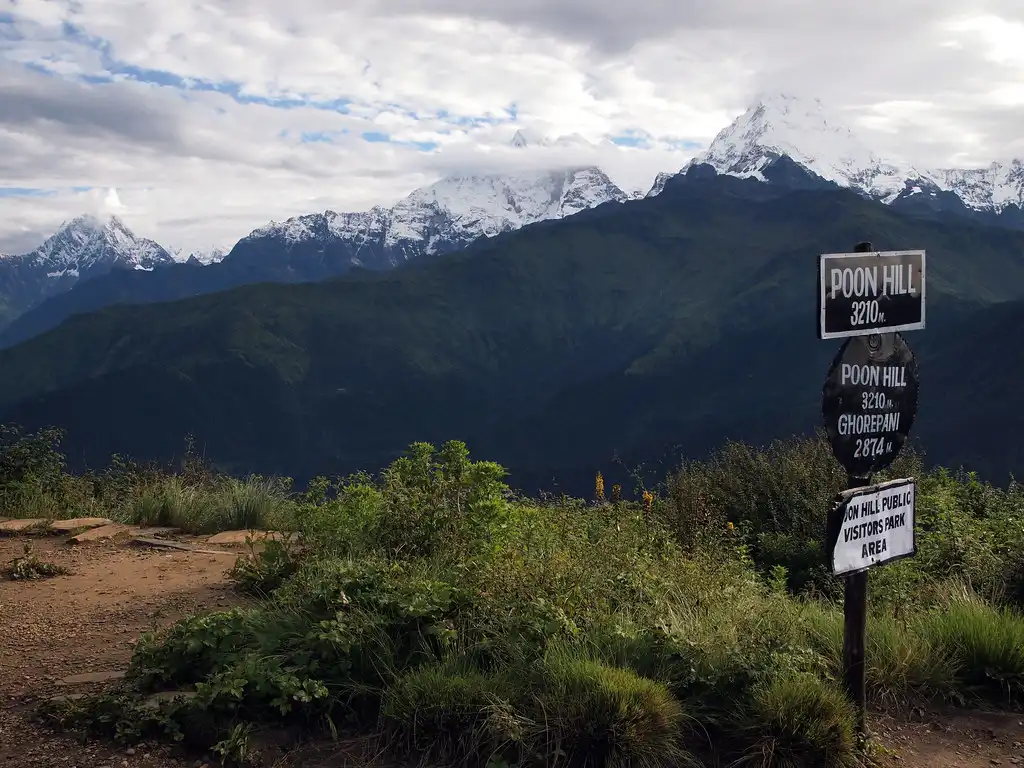
This brief trek not only offers a glimpse into the Himalayan landscapes but also acquaints you with the cultural practices and traditions of the local Tamang, Buddhist, and Thakali communities. While navigating through the diverse terrain, you’ll encounter the impressive sights of Dhaulagiri (8167m), Annapurna I (8091m), Machapuchare (6993m), and Manaslu (8157m). For those seeking to extend their adventure, they can combine the Ghorepani Poon Hill trek with trips to the Annapurna Base Camp, Mardi Himal, or the Khopra Ridge and Khayer Lake Trek.
Highlights
- Sunrise at Poon Hill: Witness a stunning sunrise over the Annapurna and Dhaulagiri ranges, casting breathtaking colors across the sky.
- Rhododendron Forests: During the spring, stroll through vibrant forests filled with blooming rhododendrons, particularly radiant during this season.
- Ethnic Villages: Explore traditional Magar and Gurung villages, immersing yourself in their rich cultural heritage and experiencing their hospitality.
- Panoramic Mountain Views: Capture spectacular views of iconic Himalayan peaks such as Dhaulagiri, Annapurna I, Machapuchare, and Manaslu.
- Accessible Trekking: Engage in a trek that is ideal for families with children and beginners, providing a fulfilling and manageable Himalayan adventure.
Best Time to Trek
Spring (March to May) Spring is a popular time to trek Ghorepani Poon Hill. Favorable weather and blooming rhododendrons enhance the trail’s beauty. The sky usually stays clear, offering great mountain views. Spring rarely sees weather-related emergencies, but occasional rain showers can occur. Helicopter rescue services work efficiently due to stable weather, providing quick assistance. Many trekkers visit during this vibrant season, making the trails busy.
Autumn (September to November) Autumn is another great time to trek Ghorepani Poon Hill. The weather remains stable, with mild temperatures and clear skies, giving spectacular Himalayan views. Emergencies are rare, thanks to predictable weather. Helicopter services are readily available and operate efficiently, ensuring trekker safety. The trails are lively and full of energy, attracting a high number of trekkers.
Winter (December to February) Winter offers a quieter trekking experience at Ghorepani Poon Hill. Fewer trekkers use the trails, and a light snow cover creates a serene landscape. The cold, especially at higher altitudes, can be severe, and snowfall might increase accident risks. Helicopter rescues may face delays due to unpredictable weather. Trekkers choosing this season enjoy peace but must prepare well for the cold.
Monsoon (June to August) The monsoon season is the least advisable time for trekking Ghorepani Poon Hill. Heavy rains make the trails slippery and increase landslide risks. Visibility often drops, and the lush scenery comes with challenges like leeches. Emergencies happen more frequently, and helicopter rescues become difficult and sporadic. More trekkers pick this season, leading to quieter but riskier trails.
Route Description
Starting Point (Nayapul): The trek on the Ghorepani Poon Hill commences in Nayapul, a convenient one-hour drive from Pokhara. This small town acts as the gateway for numerous treks throughout the Annapurna region.
Tikhedhunga and Ulleri: Leaving Nayapul, trekkers pass through Tikhedhunga, nestled along the Burundi River, where welcoming teahouses invite a restful pause. The route progresses to Ulleri, a village noted for its rigorous climb up a steep series of stone steps, presenting a significant physical challenge that marks the first intense leg of the trek.
Ghorepani: Ascending from Ulleri, the path reaches Ghorepani, a charming village perched at 2,850 meters. Historically, it was a vital stop for water on trade routes—hence the name “horse water.” Ghorepani now offers stunning views of the surrounding mountains and is an essential acclimatization point for trekkers. The village provides various lodging options and serves as the starting point for the predawn hike to Poon Hill.
Poon Hill: At an elevation of 3,210 meters, Poon Hill stands as the pinnacle of the trek and its most celebrated highlight. Known for its spectacular sunrises, trekkers ascend from Ghorepani in the early morning to witness the sun casting golden light over the Annapurna and Dhaulagiri ranges. The panoramic views from Poon Hill, capturing several towering Himalayan peaks, offer trekkers memorable vistas and excellent photographic opportunities.
Challenges
Steps and Elevation: The trek includes numerous steep steps, notably near Ulleri, which demand considerable physical effort. The altitude at Poon Hill also requires trekkers to be mindful of altitude sickness, though it is generally manageable.
Busy Trails: As one of Nepal’s most favored short treks, the Ghorepani Poon Hill Trek often experiences crowded trails, particularly during peak seasons, which may lessen the sense of solitude for some trekkers.
Accommodation and Permits
Lodging Options: A variety of teahouses and lodges along the Ghorepani Poon Hill Trek provide everything from basic to comfortable accommodations. These facilities offer warm beds, hot meals, and a taste of traditional Nepali hospitality.
Trek Permits: Trekkers must secure a TIMS (Trekkers’ Information Management System) card and an Annapurna Conservation Area Permit (ACAP). These permits are obtainable in Kathmandu or Pokhara and are crucial for trail maintenance and supporting conservation initiatives in the region.
5. Dhaulagiri Trek
The Dhaulagiri Trek is recognized as one of the most demanding trekking adventures globally, requiring robust physical and mental fitness along with prior trekking experience. This trek begins in Beni and concludes at Nayapul. For those with time constraints, they can omit the segment encompassing the Ghorepani Poon Hill Trek.
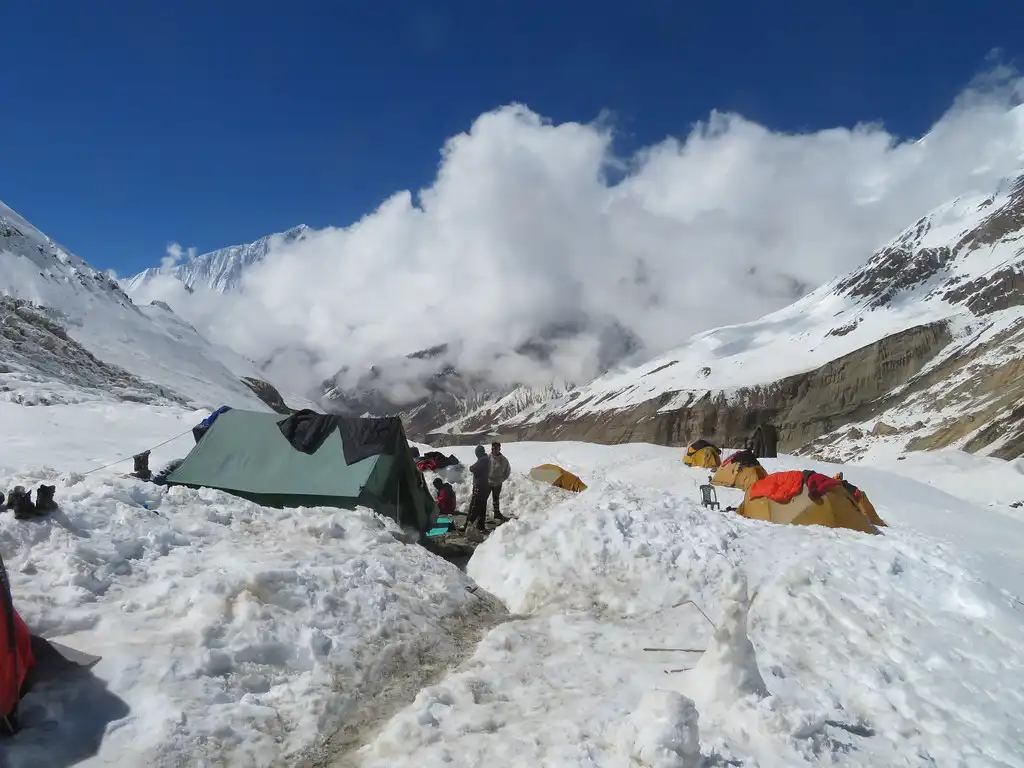
Dhaulagiri, the world’s ninth-highest mountain, lies along a less-frequented trekking path, offering trekkers the opportunity to explore a wild, rugged landscape with breathtaking mountain vistas. Along the way, an experienced Climbing Sherpa guides you to Italian Base Camp and Dhaulagiri Base Camp, navigating high mountain passes to venture into the secluded hidden valley. The hot springs at Tatopani are a highlight of this trek.
Starting from Beni, the trek proceeds to Dhaulagiri Base Camp via Italian Base Camp and French Base Camp within ten days. From Dhaulagiri Base Camp, the route descends through picturesque Marpha Village, Kalopani, and Tatopani before passing through Ghorepani and Ghandruk, culminating the adventure at Nayapul.
Highlights
- Dhaulagiri Base Camp: Experience the thrill of reaching the base camp for Dhaulagiri, the world’s ninth-highest mountain, and enjoy close-up views of its towering peaks.
- Remote Trails: Navigate through the Himalayas on less trodden, pristine trails that showcase the region’s untouched natural beauty.
- High Mountain Passes: Cross challenging high mountain passes, including the French Pass, to access the secluded Hidden Valley.
- Tatopani Hot Springs: Unwind in the soothing, naturally warm waters of the Tatopani hot springs after demanding trekking days.
- Cultural Interaction: Connect with the local communities in scenic villages like Marpha, Kalopani, and Ghandruk and discover the rich cultural heritage of the area.
Best Time to Trek
Spring (March to May): Spring is a great time to trek around Dhaulagiri. The weather is usually stable and warm, providing great visibility of the Dhaulagiri range. Flora blooms along the paths, enhancing the trek’s beauty. Weather-related emergencies are rare, but sudden weather changes can still occur. Clear weather makes helicopter rescue services more reliable, ensuring timely help. The number of trekkers grows in spring, making the trails busier and more friendly.
Autumn (September to November): Autumn also offers prime conditions for trekking Dhaulagiri. Stable weather and clear skies allow for uninterrupted mountain views. The cool, comfortable temperatures and low rainfall make it ideal for high-altitude hiking. Emergencies are less frequent, and efficient helicopter services ensure robust safety measures. Like spring, autumn attracts many trekkers, creating a lively atmosphere on the trails.
Winter (December to February): Winter presents challenges for trekking Dhaulagiri. The region gets very cold and experiences heavy snowfall, especially at higher altitudes. These conditions raise the risk of avalanches and other winter emergencies. Severe weather and limited daylight reduce the reliability of helicopter rescues. Fewer trekkers venture out, offering a more solitary but riskier trekking experience.
Monsoon (June to August): The monsoon season is the least advisable time to trek Dhaulagiri. Heavy rains make the trails slippery and increase the risk of landslides. Visibility often drops, and weather-related emergencies become more common. Adverse weather conditions challenge helicopter rescue operations, making them less frequent and reliable. With fewer trekkers, the trails are quieter but more dangerous.
Route Description
Starting Point (Beni): The trek on the Dhaulagiri begins in the vibrant town of Beni, located where the Kali Gandaki and Myagdi rivers meet. Trekkers set out from here, following the Myagdi Khola westward to the village of Darbang, marking the start of a gradual ascent.
Towards Dharapani: Leaving Darbang, the path turns north and cuts through dense forests typical of Nepal’s lower elevations. This stretch to Dharapani unfolds on less-traveled paths, offering trekkers a genuine wilderness experience.
Ascending to Italian Base Camp: Beyond Dharapani, the trail steepens and challenges increase, leading to the Italian Base Camp.
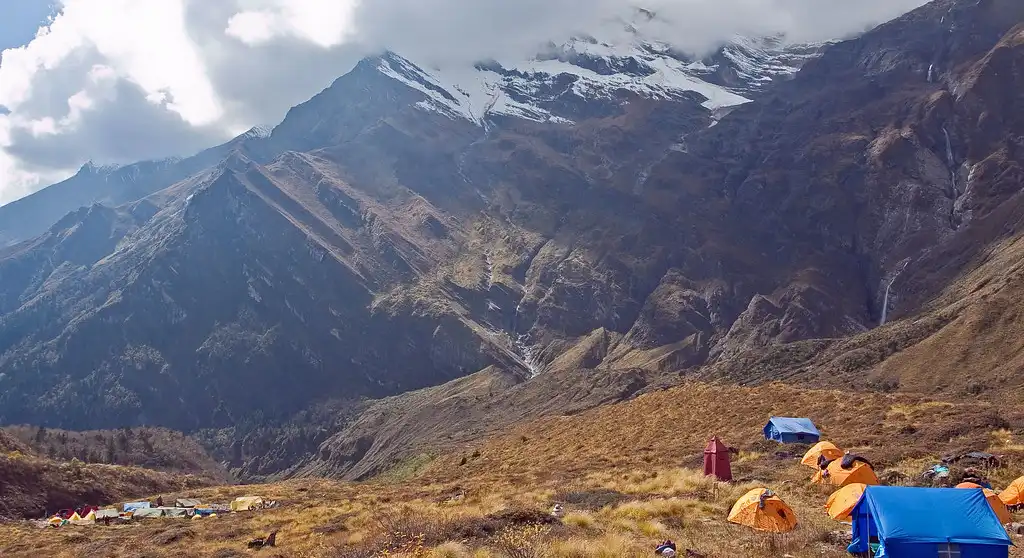
This site is essential for acclimatization and provides the first up-close views of the formidable Dhaulagiri massif. The approach involves navigating rocky cliffs and undertaking the initial glacier traverses.
Dhaulagiri Base Camp: The route from the Italian Base Camp to the Dhaulagiri Base Camp is strenuous, with significant altitude gains and extensive travel across glaciers. The terrain becomes stark and rugged, presenting dramatic landscapes and the challenge of moving through crevasses and icefalls.
Key Vantage Points (French Pass and Hidden Valley): The trek progresses toward the French Pass, a remarkable high-altitude pass at 5,360 meters, offering expansive views of Dhaulagiri and surrounding peaks. Crossing this pass leads into the Hidden Valley, a secluded area with unique landscapes and a profound sense of isolation, perfect for experiencing the serenity of the high Himalayas.
Descent to Jomsom: After exploring the Hidden Valley, the path descends to Jomsom, a well-known trekking center in the Annapurna region. This part of the trek contrasts earlier high-altitude experiences with easier trails and the lively atmosphere of local villages, showcasing the region’s thriving trekking culture.
Challenges
Technical Trekking Sections: The Dhaulagiri Trek includes sections that demand technical climbing skills and the ability to traverse icy glaciers. Trekkers must possess proficient mountaineering abilities and carry the appropriate equipment to navigate these challenging parts successfully.
Extreme Weather Conditions: The high-altitude terrain of the Dhaulagiri Trek often experiences unpredictable and severe weather conditions, including the possibility of sudden snowfalls and drastic temperature drops. Trekkers must prepare thoroughly to handle these extreme conditions effectively.
Accommodation and Permits
Camping Arrangements: The Dhaulagiri Trek requires camping in remote and isolated areas, far from commercial facilities.
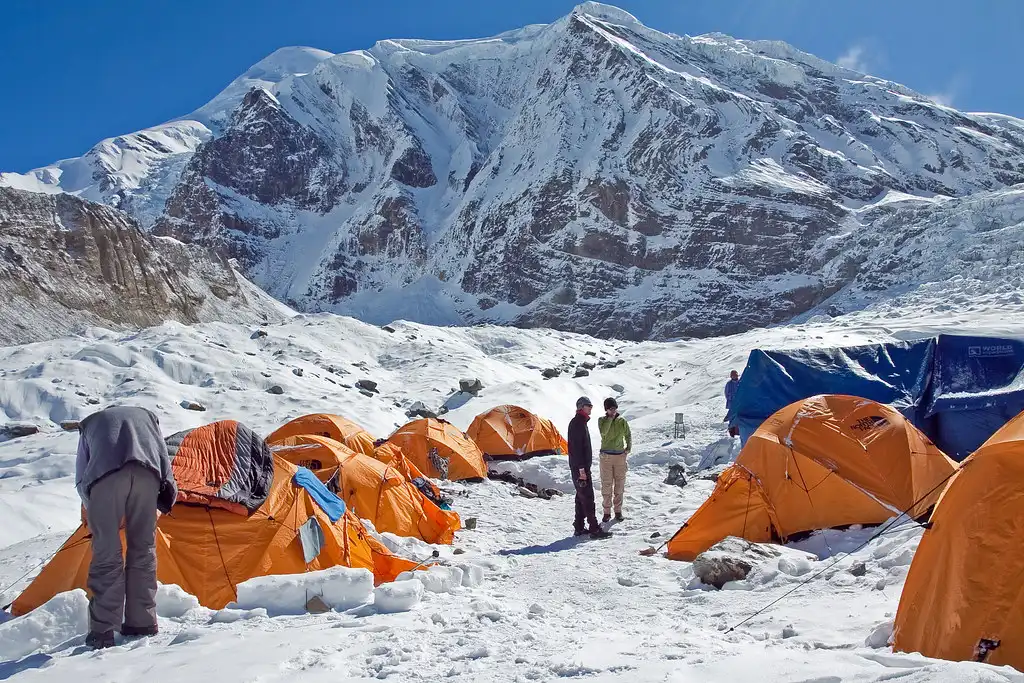
Trekkers need to bring tents and adequate supplies. This element of the trek enhances the sense of adventure but also requires meticulous planning and a high degree of self-sufficiency.
Special Permits: Navigating through the remote and ecologically sensitive areas of the Dhaulagiri circuit necessitates special trekking permits. Trekking agencies experienced in managing the regulatory and environmental protocols of such expeditions must obtain these permits.
Conclusion
Each trek across the Annapurna region distinguishes itself with its special highlights and inherent challenges. The Ghorepani Poon Hill Trek delights with its stunning sunrise views and colorful rhododendron forests. At the same time, the Dhaulagiri Trek tests your limits with its secluded, rough terrains and the need for technical climbing and glacier navigation. Trekkers face varied obstacles, from navigating crowded trails on the more popular routes to overcoming the demanding and isolated conditions of higher altitude treks such as Dhaulagiri.
When deciding on a trek, carefully evaluate your physical fitness and prior trekking experience. Beginners or those seeking a gentler adventure might find the Ghorepani Poon Hill Trek ideal, offering breathtaking views without significant technical demands. Conversely, experienced trekkers looking for a rigorous challenge might choose the Dhaulagiri Trek, demanding robust mountaineering skills and high endurance. Matching a trek to your personal preferences and abilities is key to a rewarding trekking experience.

